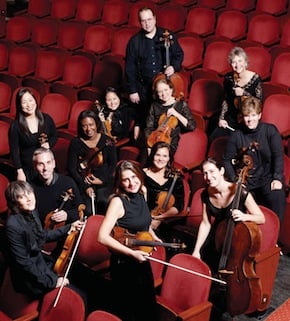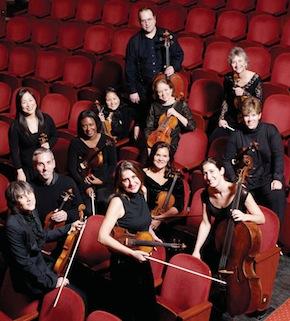
Now in its 20th anniversary season, the always enterprising New Century Chamber Orchestra continues to expand the boundaries of classical music. Thursday evening at Berkeley’s First Congregational Church, the San Francisco-based string ensemble under Music Director Nadja Salerno-Sonnenberg pushed the margins a little bit further with an illuminating program featuring two contrasting, yet ultimately congenial, mandolin concertos.
In addition to the featured works — Mike Marshall’s Mandolin Concerto No. 1, with the composer as soloist; and Vivaldi’s Concerto for Mandolin in C Major, with Caterina Lichtenberg as soloist — Thursday’s program also included contemporary works by John Adams, Evan Price, and Gordon Getty. Repeat performances continue through Sunday in Palo Alto, San Francisco, and San Rafael.
For most composers, the mandolin will probably never supplant the violin or piano as the solo instrument of choice. Yet it played a significant role for Baroque masters such as Vivaldi, who used it in his oratorio, Juditha triumphans, and two concertos (one for solo mandolin, one for mandolin duo). In the 19th century, as orchestras grew larger and louder, the mandolin receded, but in recent years the instrument has experienced a kind of Renaissance. From bluegrass to classical music, it’s now returning to center stage in a variety of settings.
Marshall, who seems equally at ease in bluegrass and Baroque, embraces multiple traditions in his concerto. Composed in 2006 on commission from the Plucked Strings Foundation, the three-movement work combines formal structure with an improvisational heart, affording the soloist plenty of opportunity for expression while displaying the composer’s command of orchestral color and texture.
As the orchestra introduced a measured march theme, Marshall entered plucking and strumming a honey-toned, amplified instrument; the listener heard American folk idioms set against a contrapuntal scheme hearkening back to Bach.
In the central movement, Marshall switched from a conventional mandolin to a larger mandocello (a cousin to the violoncello) which, when advanced over the orchestra’s low strings, produced a tender, singing sound. In the finale, which employs bits of Appalachian folk tunes and other American “roots” music, Marshall played with arresting force.
Vivaldi’s concerto, which preceded Marshall’s, served as an excellent introduction, and Lichtenberg, a professor of mandolin studies at Cologne Music Conservatory and a frequent collaborator with Marshall, is a virtuosic interpreter. She voiced with crisp articulation in the buoyant first movement (with pointed continuo contributions by NCCO’s principal cellist, Susan Babini, and principal bass, Anthony Manzo). With Salerno-Sonnenberg and the ensemble supplying lush string sound, Lichtenberg negotiated the central Largo and the charming finale with agility.
Marshall and Lichtenberg returned for a duo encore, the Brazilian tune Nao me toques. Zesty, rhythmically insinuating, it offered a jazzy, if no less beguiling, side of the mandolin.
The rest of the program was just as fine. After intermission, the orchestra gave a gripping performance of Adams’ Shaker Loops. Originally scored for string septet, Adams’ 1978 composition was arranged for string orchestra in 1983; Salerno-Sonnenberg and her players blazed through the 30-minute performance sounding well-tuned and vibrant, with the agitated outer movements framing the spacious inner episodes with firm rhythmic definition and considerable grace.
Evan Price’s Emergence, performed in the concert’s first half, also made a strong impression. Cast in three continuous movements, the score is an engaging study in orchestral layering, from the first movement’s slow descending motive for violins to a chorale-like interlude and the fleet, fused music of the finale. The NCCO players presented a unified front, and the work came off sounding splendid.
Getty’s lovely Four Traditional Pieces opened the program in a performance of disarming sonorities. Each episode in the quartet explores harmonic conventions through a distinctly nostalgic lens; the music’s echoes of vivacious dance tunes and sweet, folk-tinged melodies recall the parlor songs of a bygone era. With Salerno-Sonnenberg spinning out the solo violin part with warm, yearning tone, the score made an apt curtain-raiser for the new American mandolin music that followed.

